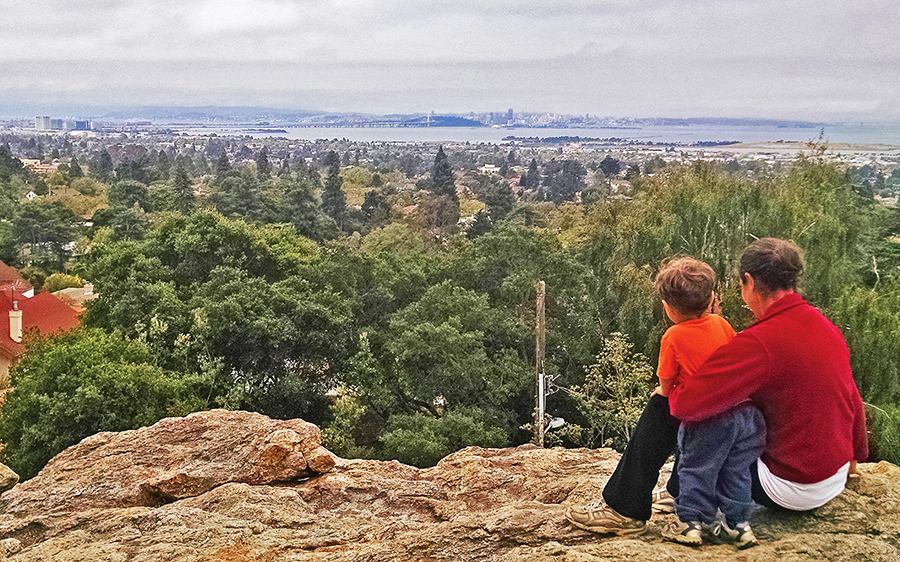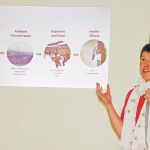
Bay Area officials are attempting to better account for unpredictability in their latest efforts to plan for the region’s future. Photo by Alec MacDonald.
While the Bay Area economy continues to hum, policymakers are exploring various “what ifs” to decide how the region should react when economic output, population, and employment abruptly busts.
This type of planning isn’t necessarily new. State, regional, and local officials routinely set aside rainy day reserves to combat the unforeseen. But at a time when affordable housing and reliable transportation are visible problems, regional planners are picturing new scenarios associated with economic contraction and expansion that could affect the Bay Area’s potential to prosper over the next three decades. They’re also addressing questions about transportation technology, frequent disasters, and political and environmental factors — all of which are unique but also intertwined with the regional economy.
The planning exercise, known as “Horizon,” is spearheaded by the recently merged Metropolitan Transportation Commission (MTC) and Association of Bay Area Governments (ABAG). By exploring external forces, the agencies are attempting to incorporate flexibility and responsiveness into what has traditionally been a statutorily-bound regional planning process.
Horizon’s objective is to “tackle uncertainties that exist in our region, nation, and our world that could affect the Bay Area,” said Dave Vautin, Horizon’s project manager.
For example, how can the Bay Area improve resilience to national and international geopolitical and economic shifts? Or, what might different levels of autonomous vehicle adoption mean for the transportation investment pipeline?
Horizon is expected to be complete in June 2019, feeding policy ideas to the next iteration of Plan Bay Area, the region’s transportation and land-use planning roadmap.
Similar work is occurring in San Francisco, where Mayor Mark Farrell asked city officials to produce a list of recession mitigation strategies by September 1 as part of an economic resiliency plan conceived in 2016. They want to buffer against projections that a severe downturn in the city’s technology sector could result in more than 54,000 jobs lost and a 9.4 percent unemployment rate, according to a May 8 press release. San Francisco’s economic reserves, including rainy day funds, total $449 million, close to the city’s goal.
At the state level, California is saving for uncertain times, too. Officials expect to have amassed $9.4 billion in rainy-day reserves by the end of the current fiscal year, according to a May 11 press release. Still, it is uncertain when the next economic slowdown could occur. Trade tensions and the potential for higher U.S. inflation and interest rates are among broad factors that could hurt regional confidence and expansion going forward, economists said.
“We certainly have challenges in terms of housing affordability and transportation, but we had those in a period when GDP and job growth outpaced the nation,” said Stephen Levy, director of the Center for Continuing Study of the California Economy (CCSCE). “So they could crimp growth in the Bay Area, although they have not yet.”
In fact, signs point to companies and communities responding by planning for the future, Levy said. The Bay Area posted a 1.8 percent job growth rate for a 12 month-period ending in March, slightly below the state average but still above the 1.5 percent U.S. gain, according to CCSCE data. Housing permit levels are rising, too, especially in Alameda and Contra Costa counties.
But positive growth effects are not evenly distributed, especially when it comes to finding an affordable place to live. For example, a family of two workers with an annual household income of $62,400 can afford the median market rent in only five percent of the Bay Area’s 1,500-plus neighborhoods. That’s according to a new report from Bay Area Equity Atlas, a partnership between PolicyLink, The San Francisco Foundation, and the Program for Environmental and Regional Equity at the University of Southern California.
“We have a volatile economy, and even when it does well, it’s not helping everybody,” said Cynthia Kroll, chief economist and assistant director for integrated planning at MTC and ABAG.
History as a Guide
So, how do you account for and design policy solutions to not only prepare for the worst, but also cultivate an environment that is fair, sustainable, and creates opportunities for residents and communities?
To kick-start the thinking process, Horizon pinpoints five guiding principles: affordability, connectivity, diversity, health, and vibrancy. The last of these emphasizes the economy and a vision of the Bay Area as an “innovation leader, creating job opportunities for all and ample fiscal resources for communities.”
Beyond these principles, local history offers a guide about the region’s boom-and-bust nature, dating back to the California Gold Rush. It’s also demonstrated resilience to unanticipated events like the 1906 earthquake and World War II, the latter of which ushered in major shifts to population and the economy.
More recent inspiration can be gleaned from public management officials who offered advice after facing challenges around development and social change in the ’70s and ’80s, sustained growth in the ’90s, and the dot-com bust in the early 2000s.
Henry Gardner served as Oakland’s city manager between 1981 and 1993, a period he described as affected by two recessions and then later by corporate departures, job losses, and housing deterioration in the form of vacancies and abandonment.
He recalled several headwinds with which he and other public management officials dealt. One was the crack-cocaine epidemic “terrorizing the community,” he said. The other was the 6.9 Loma Prieta earthquake in 1989, which destroyed a segment of the San Francisco-Oakland Bay Bridge. Two years later, the Oakland Hills Firestorm destroyed several thousand single-family homes.
“Oakland is a fascinating and dynamic place to be involved at any level in civic engagement,” Gardner said. “One has to be well rested to perform on that stage.”
He attributed the city’s ability to emerge from rocky times, in part, to former Oakland Mayor Lionel Wilson (1977 to 1991) and Wilson’s downtown economic development vision to stimulate long-term growth.
“I think the leaders of the community, both elected and non-elected and professional staff, never lost faith in what the future held for Oakland,” Gardner said.
Rod Diridon Sr., a vocal proponent of modern transit service in Silicon Valley for decades, was instrumental in campaigning for a half-cent sales tax in 1976 that still helps fund the Santa Clara Valley Transportation Authority today.
The cash infusion helped bring light rail to Santa Clara County, in anticipation of population growth and transit demand, said Diridon, who has served as chair of three regional agencies: MTC, ABAG, and the Bay Area Air Quality Management District. Light rail, which serves 30,000 weekday riders, will eventually connect to California High-Speed Rail at San Jose’s Diridon Station, a central hub.
Both Diridon and Gardner consistently advised that planners not overlook the need to offer high-density or high-rise housing near public transit stations to encourage ridership, as well as contribute to traffic and greenhouse-gas reduction goals.
Housing needs associated with Silicon Valley’s light rail system were not looked at “as seriously as we should of,” Diridon said. The shortcoming became clear in the early 2000s when it was difficult to recruit for “service-level” jobs such as police officers and fire fighters. Those challenges persist today because of the imbalance between affordable housing and well-paying jobs.
The lesson now is “we’re reaching the point of crisis in terms of access to employment in Silicon Valley,” added Diridon. “That crisis can be met by hauling people longer distances on mass transit, but it’s not going to be met on highways.”
To increase housing supply, Diridon has long advocated putting high-rise apartment or condominium units atop a multi-acre podium platform to construct a village of sorts above transit stations and station parking.
Whatever form new housing development takes, it remains a core priority that planners need to be thinking about creatively with solutions that are long-term to make sure the Bay Area remains economically important. Both housing and transportation systems need a greater amount of flexibility in them to be successful and thrive during periods of economic growth.
“Planning is not about predictions,” said Egon Terplan, regional planning director at the San Francisco-based nonprofit SPUR. “It’s about ensuring institutions allow for future outcomes.”
Residents can read more about the broader impacts of Horizon’s guiding principles in “perspective papers” as they’re released online and at expert panel discussions over the next 12 months. In June, Horizon dives into autonomous vehicles and future mobility. Panel discussions will feature the paper’s lead author, in addition to experts from nonprofit organizations, government, and the private sector. The papers “will propose a set of strategies that could be considered by the public to move forward,” Vautin said.
Strategies will be explored through a lens of potential “futures,” or ideas about what the Bay Area would look like if, for example, it experienced three feet of sea level rise or the completion of high-speed rail between San Francisco and Los Angeles. Project evaluation will then follow in the fall, based on a detailed understanding of how the Bay Area would fare under various futures, assuming current policies and investments are not changed to improve the outcomes, Vautin said.
“We will be able to describe opportunities and challenges related to transportation, housing, the economy, the environment, and social equity in each future using model-based analyses,” he said.
During Horizon’s evaluation period, residents, advocates, and other stakeholders can give input at outreach events. MTC and ABAG also will engage with residents via social media throughout the planning effort. Public participation will likely be robust, if the early going is any indication. The first round of outreach for Horizon this past winter — including “pop-ups” across the Bay Area and an online survey about the region’s aspirations — generated more than 10,000 comments.
Cecily O’Connor covers transportation for the Monitor.

